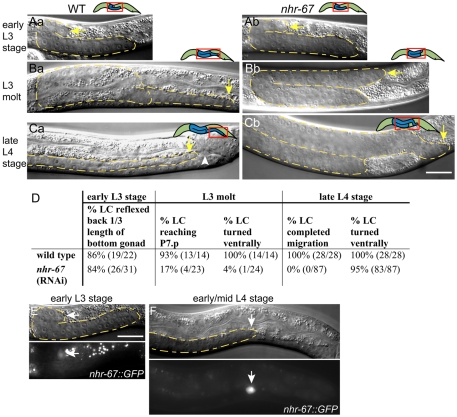Fig. 2.
nhr-67 is required for gonad migration during the L3 and L4 stages. (A-C) Comparison of gonad migration in wild-type and nhr-67(RNAi) animals. The gonads of wild-type (Aa,Ba,Ca) and nhr-67(RNAi) (Ab,Bb,Cb) animals are shown at the early L3 stage (A), the L3 molt (B), and the late L4 stage (C). (A) The gonads appear identical in the early L3 stage. The LCs are indicated by arrows and the gonads are outlined in yellow. (B) By the L3 molt, the gonad has turned from the dorsal to the ventral side in the wild type (Ba) but not in the nhr-67(RNAi) animal (Bb). Also, the gonad migration is slower in the nhr-67(RNAi) animal. (C) By the late L4 stage, in the wild-type animal the gonad has completed its migration, having reached the cloaca (Ca, arrowhead). In the nhr-67(RNAi) animal, the gonad does not complete its migration, but does finally turn ventrally (Cb). (D) Summary of the wild-type versus nhr-67 gonadal characteristics for the early L3 stage, L3 molt, and late L4 stage. (E,F) Nomarski images (top) and fluorescence images (bottom) of gonads in an early L3 stage (E) and an early/mid-L4 stage (F) wild-type animal. nhr-67::GFP is expressed in the LC (arrow). Scale bars: 20 μm.

